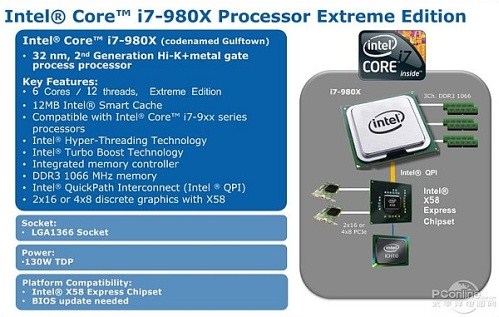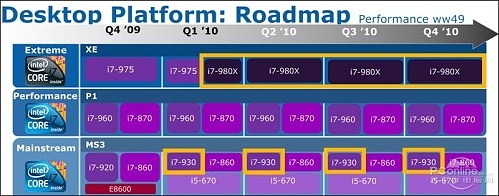For the past few months, Intel has been reluctant to supply its enthusiast and enterprise markets with a naming scheme for the upcoming Westmere-based 32nm six-core chips (codenamed “Gulftown”) that it has planned for its high-end processor segment in 2010.
Many journalists, analysts and consumers have been speculating the possibility that the company would retreat from the “Core i7” naming scheme for two particular reasons. Due to the nature of 32nm manufacturing process exhibiting fabrication improvements over 45nm, it was initially anticipated that Gulftown chips were to be labeled under the “Core i9”identifier. The second and perhaps more reasonable theory assumed that the products would be labeled “Core i9” because they carry a higher core count than the current high-end offerings (see: “Core i7 + 2” analogy) and an increased 12MB cache design. In addition, they feature inclusion of the new Advanced Encryption Standard (AES-NI) instruction set and a sustained 130W TDP, allowing for an incredible 21.7W per core with exceptional overclockability.
Today, all popularly prevailing rumors of the six-core behemoth’s naming strategy can be disregarded, and we are now pleased to present the official details without making any more assumptions. In fact, we wrote in September that the only retail fact we were able to confirm were images of the stock heatsink that Intel will include with its new flagship, brute-force solution to Moore’s Law. Nevertheless, it should be noted that we apologetically regret the fact that we inappropriately labeled the processor as belonging to the “Core i9” family. Sources within Intel’s product marketing sector have stated that the company intends to continue its current trend of using “Core i7” as its high-end product identifier, and we suspect this will not change over the course of the next year, at least not until the 22nm Sandy Bridge microarchitecture arrives.
Without further ado, the official name of Intel’s flagship 32nm desktop chip is Core i7 Extreme 980X. News of the confirmation comes from Chinese-based site PCOnline.com.cn which claims to have an official revised Intel roadmap in its hands. Judging by the image, the roadmap does seem valid and official with an “Intel Core i7” logo slapped above the X58 architecture layout image. On another note, the site states that the new flagship desktop chip will run at 3.33GHz, which basically makes it a Core i7 Extreme 975 with all the quirks of the 32nm Westmere family architecture and two additional cores.


As an Extreme Edition chip, the Core i7 Extreme 980X 3.33GHz will likely be priced at $999. This is not unexpected in any way, as Intel has stated many times over that it intends to reserve the X58 chipset and more broadly, the LGA 1366 platform, for its flagship high-end processors. In other words, it could likely mean that the socket will migrate toward being catered for the reality of “Extreme Edition-only,” but this assumption has yet to be confirmed.
With the advent of six cores in the desktop space and significantly improved headroom for overclocking with the 32nm manufacturing process, it has been difficult trying to get our heads around the idea of quantifying real-world performance improvements with the Core i7 980X. In fact, coming up with a list of multi-core intensive games in the 21st century that can utilize more than two cores is a scientific achievement in itself. We were thinking something along the lines of “Intel Core i7-980X. Optimized for Nintendo 64 emulation.” but even an application like that would make the chip stagger along without a mild overclock.
All sarcasm aside, we wanted to leave our enthusiast die hardreaders with a new speculative theory to get excited about. Despite consistent statements that the Core i7 Extreme 980X chip, formerly referred to as "32nm Gulftown," has been delayed until Q2 2010, several sites have stated that the flagship desktop processor will be launching in March 2010, otherwise known as late Q1 2010. Should this release date theory receive confirmation, we can conclude that Nehalem-based Core i7 processors will have lived a long and successful life, as the Core i7 Extreme 965 will have lived sixteen months from November 2008 to March 2010.

